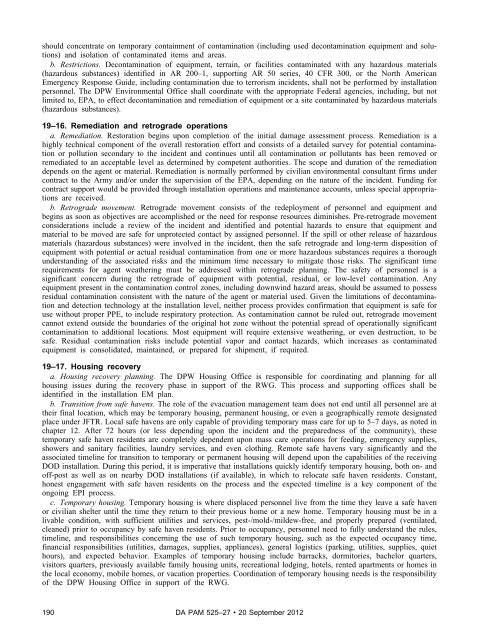Army Emergency Management Program - Federation of American ...
Army Emergency Management Program - Federation of American ...
Army Emergency Management Program - Federation of American ...
Create successful ePaper yourself
Turn your PDF publications into a flip-book with our unique Google optimized e-Paper software.
should concentrate on temporary containment <strong>of</strong> contamination (including used decontamination equipment and solutions)<br />
and isolation <strong>of</strong> contaminated items and areas.<br />
b. Restrictions. Decontamination <strong>of</strong> equipment, terrain, or facilities contaminated with any hazardous materials<br />
(hazardous substances) identified in AR 200–1, supporting AR 50 series, 40 CFR 300, or the North <strong>American</strong><br />
<strong>Emergency</strong> Response Guide, including contamination due to terrorism incidents, shall not be performed by installation<br />
personnel. The DPW Environmental Office shall coordinate with the appropriate Federal agencies, including, but not<br />
limited to, EPA, to effect decontamination and remediation <strong>of</strong> equipment or a site contaminated by hazardous materials<br />
(hazardous substances).<br />
19–16. Remediation and retrograde operations<br />
a. Remediation. Restoration begins upon completion <strong>of</strong> the initial damage assessment process. Remediation is a<br />
highly technical component <strong>of</strong> the overall restoration effort and consists <strong>of</strong> a detailed survey for potential contamination<br />
or pollution secondary to the incident and continues until all contamination or pollutants has been removed or<br />
remediated to an acceptable level as determined by competent authorities. The scope and duration <strong>of</strong> the remediation<br />
depends on the agent or material. Remediation is normally performed by civilian environmental consultant firms under<br />
contract to the <strong>Army</strong> and/or under the supervision <strong>of</strong> the EPA, depending on the nature <strong>of</strong> the incident. Funding for<br />
contract support would be provided through installation operations and maintenance accounts, unless special appropriations<br />
are received.<br />
b. Retrograde movement. Retrograde movement consists <strong>of</strong> the redeployment <strong>of</strong> personnel and equipment and<br />
begins as soon as objectives are accomplished or the need for response resources diminishes. Pre-retrograde movement<br />
considerations include a review <strong>of</strong> the incident and identified and potential hazards to ensure that equipment and<br />
material to be moved are safe for unprotected contact by assigned personnel. If the spill or other release <strong>of</strong> hazardous<br />
materials (hazardous substances) were involved in the incident, then the safe retrograde and long-term disposition <strong>of</strong><br />
equipment with potential or actual residual contamination from one or more hazardous substances requires a thorough<br />
understanding <strong>of</strong> the associated risks and the minimum time necessary to mitigate those risks. The significant time<br />
requirements for agent weathering must be addressed within retrograde planning. The safety <strong>of</strong> personnel is a<br />
significant concern during the retrograde <strong>of</strong> equipment with potential, residual, or low-level contamination. Any<br />
equipment present in the contamination control zones, including downwind hazard areas, should be assumed to possess<br />
residual contamination consistent with the nature <strong>of</strong> the agent or material used. Given the limitations <strong>of</strong> decontamination<br />
and detection technology at the installation level, neither process provides confirmation that equipment is safe for<br />
use without proper PPE, to include respiratory protection. As contamination cannot be ruled out, retrograde movement<br />
cannot extend outside the boundaries <strong>of</strong> the original hot zone without the potential spread <strong>of</strong> operationally significant<br />
contamination to additional locations. Most equipment will require extensive weathering, or even destruction, to be<br />
safe. Residual contamination risks include potential vapor and contact hazards, which increases as contaminated<br />
equipment is consolidated, maintained, or prepared for shipment, if required.<br />
19–17. Housing recovery<br />
a. Housing recovery planning. The DPW Housing Office is responsible for coordinating and planning for all<br />
housing issues during the recovery phase in support <strong>of</strong> the RWG. This process and supporting <strong>of</strong>fices shall be<br />
identified in the installation EM plan.<br />
b. Transition from safe havens. The role <strong>of</strong> the evacuation management team does not end until all personnel are at<br />
their final location, which may be temporary housing, permanent housing, or even a geographically remote designated<br />
place under JFTR. Local safe havens are only capable <strong>of</strong> providing temporary mass care for up to 5–7 days, as noted in<br />
chapter 12. After 72 hours (or less depending upon the incident and the preparedness <strong>of</strong> the community), these<br />
temporary safe haven residents are completely dependent upon mass care operations for feeding, emergency supplies,<br />
showers and sanitary facilities, laundry services, and even clothing. Remote safe havens vary significantly and the<br />
associated timeline for transition to temporary or permanent housing will depend upon the capabilities <strong>of</strong> the receiving<br />
DOD installation. During this period, it is imperative that installations quickly identify temporary housing, both on- and<br />
<strong>of</strong>f-post as well as on nearby DOD installations (if available), in which to relocate safe haven residents. Constant,<br />
honest engagement with safe haven residents on the process and the expected timeline is a key component <strong>of</strong> the<br />
ongoing EPI process.<br />
c. Temporary housing. Temporary housing is where displaced personnel live from the time they leave a safe haven<br />
or civilian shelter until the time they return to their previous home or a new home. Temporary housing must be in a<br />
livable condition, with sufficient utilities and services, pest-/mold-/mildew-free, and properly prepared (ventilated,<br />
cleaned) prior to occupancy by safe haven residents. Prior to occupancy, personnel need to fully understand the rules,<br />
timeline, and responsibilities concerning the use <strong>of</strong> such temporary housing, such as the expected occupancy time,<br />
financial responsibilities (utilities, damages, supplies, appliances), general logistics (parking, utilities, supplies, quiet<br />
hours), and expected behavior. Examples <strong>of</strong> temporary housing include barracks, dormitories, bachelor quarters,<br />
visitors quarters, previously available family housing units, recreational lodging, hotels, rented apartments or homes in<br />
the local economy, mobile homes, or vacation properties. Coordination <strong>of</strong> temporary housing needs is the responsibility<br />
<strong>of</strong> the DPW Housing Office in support <strong>of</strong> the RWG.<br />
190 DA PAM 525–27 20 September 2012
















